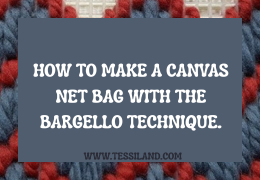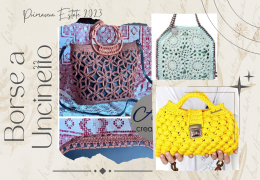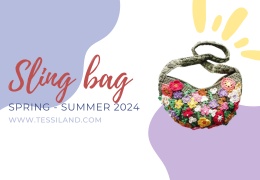Dance under the Greek sun (even if only in your imagination) with OIA, the crochet bag of the summer inspired by...
0 prodotti 0
Your cart is empty
Search in blog
Blog categories
Latest posts
-
 Oia, the crochet bag that smells like Santorini.Read more
Oia, the crochet bag that smells like Santorini.Read more -
 Summer Crochet: 3 crochet projects for your beach house and beyond.09/07/2025Read more
Summer Crochet: 3 crochet projects for your beach house and beyond.09/07/2025Read moreLooking for summer inspiration? Discover 3 easy and creative crochet projects perfect for decorating your beach...
-
 How to make a canvas mesh bag using the Bargello technique.06/07/2025Read more
How to make a canvas mesh bag using the Bargello technique.06/07/2025Read moreA rigid, colorful bag that looks like it came from a boutique—but you made it yourself. Discover how to use canvas...
-
 5 things that happen to your body when you crochet.03/07/2025Read more
5 things that happen to your body when you crochet.03/07/2025Read moreDiscover 5 surprising effects of crocheting on your body. Mental well-being, posture, relaxation, and creativity in...
-
 Mini crochet ice creams: a burst of color in a tiny version for the summer.29/06/2025Read more
Mini crochet ice creams: a burst of color in a tiny version for the summer.29/06/2025Read moreDiscover how to make mini crochet ice creams: colorful, easy, and perfect as keychains for a creative summer. Free...
Popular posts
-
 Crochet bags, the models for spring-summer.29/04/2023One of the most searched accessories on the web, patterns, tutorials, ideas, projects, accessories, here's how to...Read more
Crochet bags, the models for spring-summer.29/04/2023One of the most searched accessories on the web, patterns, tutorials, ideas, projects, accessories, here's how to...Read more -
 Crochet bags for spring summer 2024. 5 models of handmade sling bags.05/04/2024Discover the latest trends for Spring/Summer 2024 with our exclusive guide to 5 crochet sling bag models. Perfect for...Read more
Crochet bags for spring summer 2024. 5 models of handmade sling bags.05/04/2024Discover the latest trends for Spring/Summer 2024 with our exclusive guide to 5 crochet sling bag models. Perfect for...Read more -
 The Crochet Net Bucket Bag: A Trendy Accessory for 202401/06/2024Learn how to make a crochet net bucket bag with our simple and detailed tutorial. Use elastic cord, a size 5 crochet...Read more
The Crochet Net Bucket Bag: A Trendy Accessory for 202401/06/2024Learn how to make a crochet net bucket bag with our simple and detailed tutorial. Use elastic cord, a size 5 crochet...Read more -
 Crochet rugs, a passion that is becoming a trend.21/01/2024In this article, dive into the art of crochet rugs and discover how to create unique and personalized pieces for your...Read more
Crochet rugs, a passion that is becoming a trend.21/01/2024In this article, dive into the art of crochet rugs and discover how to create unique and personalized pieces for your...Read more -
 From runways to street style: the trendiest crochet bags.06/09/2023Are you also passionate about handmade items and want to create your own capsule collection of crochet bags? Here are...Read more
From runways to street style: the trendiest crochet bags.06/09/2023Are you also passionate about handmade items and want to create your own capsule collection of crochet bags? Here are...Read more
DIY Crochet Bags: A Practical Guide to Linings, Yarn, and Seasonal Patterns.
Dear reader,
If you’ve made it all the way to this article from the DIY CROCHET BAGS series, the first thing I want to say is: THANK YOU. Not just a polite thank you. A real one. From the heart. Because if you're here, you're supporting not just a blog, but a shared idea. Mine. Ours. And now, without further ado (because I know you're here for the bags), let's get to it.
Have you ever thought about how much beauty, style, and functionality a handmade bag can hold? For me, it’s almost a love letter: to creativity, to patience, to fashion that doesn’t follow rules but reinvents them.
And if summer 2025 has one clear trend, it’s this: crochet bags, everywhere, always. One of the latest articles read on crochet proves it, especially regarding the crochet bag trend.
And since this is (for now) a farewell to the Wednesday column, let's end on a high note by answering the top 3 customer service questions. And don’t forget to check how to wash your handmade bag once it’s done.
1. DO I REALLY NEED TO LINE A HANDMADE BAG?
.png)
The million-dollar question. The one worth a million single crochets. The answer? Yes. And also no. It all depends on her: your bag.
Before diving in, here's a COMPLETE GUIDE TO LINING A HANDMADE BAG.
Pros and cons of lining:
Pros:
-
Gives the bag shape, especially if the yarn is soft,
-
Protects the contents and hides the “back” of the work,
-
Increases the durability of the bag.
Cons:
-
Takes extra time (and patience!)
-
Can add weight if poorly chosen
-
If sewn badly, it may “pull” or deform the bag
A tip? If you don’t like needle and thread, there are great fabric glues that allow you to attach the lining without sewing. It’s not the perfect solution for all models, but for a clutch or pouch, it might be the perfect ally.
REAL CROCHETTER TIP:
If you’re not into sewing, use a fabric glue: perfect for pouches and clutches, less so for structured maxi bags.
Which material should you choose for the lining?
This opens up a whole world.
- Cotton lining: my favorite for "serious" bags. It has a slightly ribbed texture, is resistant and not too stiff. Perfect for daytime bags, hobo bags, or city models.
- Salpa: a technical material often used inside for support. Looks like cardboard, but it’s flexible and sewable. Used for structure, not decoration.
- Thermo-hardening: a step up. It’s activated by ironing (but doesn’t like mistakes). Gives firmness and hold, ideal for well-defined corners and stable shapes.
- Plastic mesh: debated, yes, but useful. Good if you want internal structure and a "shell" build, but beware: if the bag is small or highly detailed, the mesh can be bulky.
- Shell: when you choose a preformed shell (like faux leather or rigid canvas), the lining isn't mandatory. They’re often reinforced and designed for direct crochet work.
Discover the differences in material application:
The point is: there is no single rule. There’s your bag, your style, and the result you want. Line it, yes—but with care.
2. HOW MUCH YARN DO YOU NEED FOR A BAG?
.jpg)
Spoiler: it depends.
I know, you’d love a clear answer, like “300 grams and done.” But when it comes to crochet bags, there are many factors—and ignoring them leads straight to the dreaded “ran-out-of-yarn halfway through the handle” drama.
So here’s a thoughtful guide to estimate how much yarn you’ll need for each basic model.
Clutch / Pouch
.jpg)
Small, elegant, perfect for beginners.
Average consumption: 100–150g of cord or technical yarn
With thin yarns or tight stitches, count up to 200g
If adding a wrist strap, lining, and embellishments: grab one extra ball
Learn how to make a CLUTCH BAG.
Medium Day Bag
.jpg)
The most loved by multitasking creatives: not too big, but fits everything.
Average consumption: 300–400g
With dense single crochet or double strands, you might reach 500g
If the structure is soft, you’ll use less than for a reinforced rigid bag
Learn how to make a CHUNKY HANDBAG.
Large Shopper / Tote
For city or beach, this is where things get serious.
Average consumption: 500–700g
If you add a rigid base and long handles, consider up to 800g
Want to use an openwork or fancy stitch? Great idea to save yarn! Check out the project I loved by Brunaticality.
Backpack or Bucket Bag
Sporty, cool, and often underestimated when it comes to yarn use.
Average consumption: 400–600g
Drawstrings, pockets, and the cylindrical shape increase the need
If it’s lined and has a reinforced base, expect at least 700g total
Make this bucket bag following my pattern: BUCKET BAG.
Beach Shell Bag
Here the star is the contrast between the rigid base (shell) and the crocheted body.
Average consumption: 200–300g
With a shaped mesh or straw-effect shell, the yarn is only for the sides or to add volume
Perfect for those who want to save yarn without giving up that “wow” effect.
Let’s follow Criss’s guidelines to make one:
Factors that influence yarn consumption.
- Stitch used: single crochet = denser = more yarn. Mesh or openwork pattern? Less yarn and more lightness.
- Type of yarn: flat cords, matte or shiny, can yield very different results. A thin yarn used double will consume more than double compared to a technical yarn used single.
- Single or double-layer construction: if you create a double base or bold borders, don’t be stingy—double the estimate too.
Advice from someone who's already made the mistakes for you.
Always, always, always get one extra ball of yarn.
It's not just about quantity: dye lots vary, yarn can run out, and nothing is more frustrating than a perfect bag... unfinished.
And come on, you can always use the leftover to make a matching keychain. Or a second bag. Because let’s face it: one leads to another.
3. A BAG FOR EVERY SEASON
.png)
Fashion changes, tastes evolve… but there’s one golden rule that remains: every season has its perfect bag.
Not just for style, but also for materials, practicality, and—let’s be honest—emotion.
Because yes, there are bags that smell like spring, others that carry the salty flavor of summer. Some follow us through autumn leaves, others shine under winter lights.
Here are my favorites, season by season.
Spring: Light as a walk.
The spring bag is like a first outing without a jacket: fresh, essential, a bit free.
Ideal? I recommend the DAISY BAG.
You can finish it in a few hours, it goes with everything, and it leaves your hands free to pick daisies, books, or inspiration.
Go for a simple, clean stitch, with a contrasting detail: a tassel, a button, a wooden clasp.
Summer: Vibrant, spacious, and salty.
The undisputed queen of the warm season is the beach bag.
Here the yarn changes: raffia, lightweight cord, jute—everything that resists sand, sun, and salt.
Large, colorful, maybe with a rigid base or shell bottom. Try making the SPRING BAG in BIG version.
Stand out with ethnic details, fringes, nautical stripes, or bamboo handles. Summer is the only season where excess is allowed. In fact, it’s encouraged.
Autumn: Compact, made for the city.
As the air turns crisp and the sky moody, the bag becomes sturdier, more compact, ready for the urban pace.
My tip? A crescent-shaped model with the brand new Pappardella ribbon, to carry by hand.
The colors? Forest, wood, black.
Here’s a tutorial by Tessiland®
Winter: Chic, soft, slightly sparkly.
When the cold arrives, we wrap ourselves in sweaters and dreams. The perfect winter bag? Structured, elegant, with a glam touch.
Choose a chunky yarn—maybe chenille, lurex, or faux fur. Add a shell base and refined details.
It’s the season for deep colors: black, midnight blue, burgundy, dark gold, and also chic tones like beige, blush, or leather. For this season, I recommend a highly loved TOTE BAG—the TEDDY BAG.
If you feel like shining, go for it. At least let your bag do it for you.
The truth? A crafter never has just one bag. She has an idea for every season.
And you? Which season are you in right now?
Rosaria Tessiland®
.jpg)



